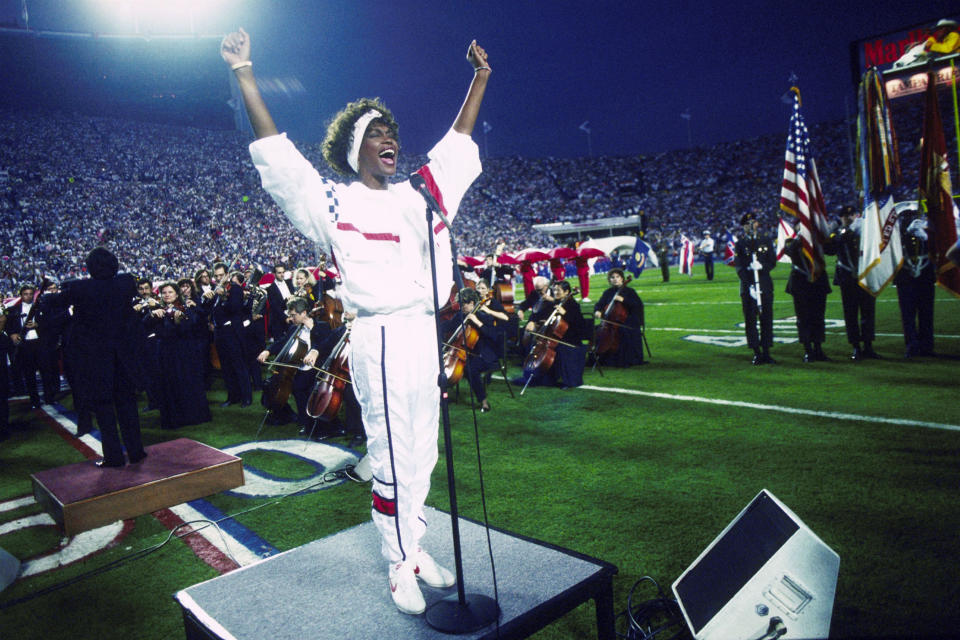Celebrate July 4 with the story behind Whitney Houston's iconic performance of 'The Star-Spangled Banner'
“The Star-Spangled Banner” will be heard from sea to shining sea when the United States celebrates its 242nd Independence Day on July 4. As rousing as many of those performances will surely be, the version of the national anthem that’s still ringing in the nation’s collective ears is Whitney Houston‘s immortal live rendition at Super Bowl XXV in February 1991. As the singer stepped up to the mic, Operation Desert Storm — when American military forces touched down in the Persian Gulf — was a mere 10 days old, providing a dramatic backdrop for Houston’s Super Bowl appearance.
Two minutes and 15 seconds later, her performance instantly became the stuff of legend, and it forms the centerpiece of the new documentary, Whitney, which opens in theaters on July 6. “She changed forever the way that song is sung,” director Kevin Macdonald says simply. “And, more importantly, the way it’s understood. She turned it from being a song about oppression and about military might into a song that was celebrating freedom.” (Watch our video interview above.)

Interestingly, Houston didn’t require a lot of preparation for the performance that would come to define her career. As disclosed in Whitney, the singer avoided extensively rehearsing the song ahead of time, trusting in her own skills as well as the energy that comes with a live performance. [Editor’s Note: Although the version of “The Star-Spangled Banner” that television viewers heard at home was pre-recorded by Houston, she did perform a live rendition of the anthem into a dead mic that could be heard by the military servicemen and women on the field.] “Particularly at the height of her career, Whitney was so confident in her abilities that she didn’t rehearse,” Macdonald explains. “That’s indicative of something people underestimate: Whitney was a great live performer, and that’s where her real musical genius usually showed. You can see the ease at which she’s playing with melody — it’s really astonishing.”
Certainly, Houston’s version of “The Star-Spangled Banner” is distinguished by the way she departs from the song’s standard melody. Under the guidance of her musical director, Rickey Minor, she turned the stately anthem into a soulful jazz-gospel hybrid. That was a major breakthrough, especially for African-American listeners. “For African-Americans up to that point, the song had been kind of an uncomfortable thing,” Macdonald says. “Various changes to the rhythm of the piece … gave her the opportunity to use her improvisational jazz/gospel flavors to make it a very gospely-sounding song with the emphasis on freedom, this great concept obviously for everyone in the world but particularly for African-Americans. Had she lived, she may have become America’s great jazz singer.”

The overwhelmingly positive reaction to Houston’s performance crossed racial and gender lines, elevating her already bright star to supernova status. It also inspired a wave of performers who have since sought to make “The Star-Spangled Banner” their own, including Beyoncé and Lady Gaga. “They’re all doing it standing on her shoulders,” Macdonald says. “And they will all admit that!”
For Houston herself, though, it represented both the culmination of her rise through the ranks of ’80s pop stars and the end of a distinct phase in her career before it headed into darker territory, as chronicled in Whitney. “It really, really cemented her place as America’s sweetheart. … She was this symbol of everything that was pure and sweet and lovely about America at that time. And then what happened later through her life was such a huge contrast. In that contrast, you see the real reason that people are fascinated with her.”
Whitney opens in theaters on July 6.
Read more from Yahoo Entertainment:

